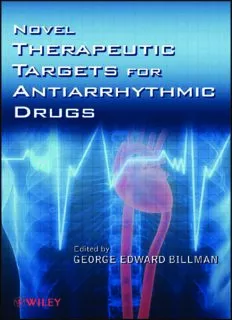
Novel Therapeutic Targets for Antiarrhythmic Drugs PDF
Preview Novel Therapeutic Targets for Antiarrhythmic Drugs
NOVEL THERAPEUTIC TARGETS FOR ANTIARRHYTHMIC DRUGS NOVEL THERAPEUTIC TARGETS FOR ANTIARRHYTHMIC DRUGS Edited by George Edward Billman Professor of Physiology andCellBiology TheOhio State University Copyright(cid:2)2010byJohnWiley&Sons,Inc.Allrightsreserved. PublishedbyJohnWiley&Sons,Inc.,Hoboken,NewJersey PublishedsimultaneouslyinCanada Nopartofthispublicationmaybereproduced,storedinaretrievalsystem,ortransmittedinanyformorby anymeans,electronic,mechanical,photocopying,recording,scanning,orotherwise,exceptaspermitted underSection107or108ofthe1976UnitedStatesCopyrightAct,withouteitherthepriorwritten permissionofthePublisher,orauthorizationthroughpaymentoftheappropriateper-copyfeetothe CopyrightClearanceCenter,Inc.,222RosewoodDrive,Danvers,MA01923,(978)750-8400,fax(978) 750-4470,oronthewebatwww.copyright.com.RequeststothePublisherforpermissionshouldbe addressedtothePermissionsDepartment,JohnWiley&Sons,Inc.,111RiverStreet,Hoboken,NJ07030, (201)748-6011,fax(201)748-6008,oronlineathttp://www.wiley.com/go/permissions. LimitofLiability/DisclaimerofWarranty:Whilethepublisherandauthorhaveusedtheirbesteffortsin preparingthisbook,theymakenorepresentationsorwarrantieswithrespecttotheaccuracyor completenessofthecontentsofthisbookandspecificallydisclaimanyimpliedwarrantiesof merchantabilityorfitnessforaparticularpurpose.Nowarrantymaybecreatedorextendedbysales representativesorwrittensalesmaterials.Theadviceandstrategiescontainedhereinmaynotbesuitable foryoursituation.Youshouldconsultwithaprofessionalwhereappropriate.Neitherthepublishernor authorshallbeliableforanylossofprofitoranyothercommercialdamages,includingbutnotlimitedto special,incidental,consequential,orotherdamages. Forgeneralinformationonourotherproductsandservicesorfortechnicalsupport,pleasecontactour CustomerCareDepartmentwithintheUnitedStatesat(800)762-2974,outsidetheUnitedStatesat(317) 572-3993orfax(317)572-4002. Wileyalsopublishesitsbooksinavarietyofelectronicformats.Somecontentthatappearsin printmaynotbeavailableinelectronicformats.FormoreinformationaboutWileyproducts,visitour websiteatwww.wiley.com LibraryofCongressCataloging-in-PublicationData: Noveltherapeutictargetsforantiarrhythmicdrugs/[editedby]GeorgeE.Billman. p.;cm. Includesbibliographicalreferencesandindex. ISBN978-0-470-26100-2(cloth) 1. Myocardialdepressants.2. Arrhythmia–Chemotherapy. I.Billman,GeorgeE. [DNLM:1. AntiarrhythmiaAgents.2. Arrhythmias,Cardiac–drugtherapy. QV150N9372010] RM347.N682010 616.1028061–dc22 2009020796 PrintedintheUnitedStatesofAmerica 10 9 8 7 6 5 4 3 2 1 ToRosemary,friend,confidante,soulmate,andlifepartner—sempergaude. CONTENTS Acknowledgments xix Contributors xxi 1. Introduction 1 GeorgeE.Billman References 3 þ 2. Myocardial K Channels: Primary Determinants of ActionPotential Repolarization 5 NorikoNiwaandJeanneNerbonne 2.1 Introduction 5 þ 2.2 ActionPotentialWaveformsandRepolarizingK Currents 7 þ 2.3 FunctionalDiversityofRepolarizingMyocardialK Channels 9 þ 2.4 MolecularDiversityofK ChannelSubunits 12 2.5 MolecularDeterminantsofFunctionalCardiacI Channels 16 to 2.6 MolecularDeterminantsofFunctionalCardiacI Channels 18 K 2.7 MolecularDeterminantsofFunctionalCardiacKirChannels 23 2.8 OtherPotassiumCurrentsContributingtoAction PotentialRepolarization 27 þ 2.8.1 MyocardialK ChannelFunctioninginMacromolecular ProteinComplexes 28 References 32 3. The ‘‘Funny’’Pacemaker Current 59 AndreaBarbuti,AnnalisaBucchi,MirkoBaruscotti,and DarioDiFrancesco 3.1 Introduction:TheMechanismofCardiacPacemaking 59 3.2 The‘‘Funny’’Current 60 3.2.1 HistoricalBackground 60 3.2.2 BiophysicalPropertiesoftheI Current 61 f 3.2.3 AutonomicModulation 63 3.2.4 CardiacDistributionofI 63 f vii viii CONTENTS 3.3 MolecularDeterminantsoftheI Current 64 f 3.3.1 HCNClonesandPacemakerChannels 64 3.3.2 IdentificationofStructuralElementsInvolvedin ChannelGating 66 3.3.3 RegulationofPacemakerChannelActivity:“Context” DependenceandProtein-ProteinInteractions 70 3.3.4 HCNGeneRegulation 71 3.4 BlockersofFunnyChannels 72 3.4.1 Alinidine(ST567) 73 3.4.2 Falipamil(AQ-A39),Zatebradine(UL-FS49), andCilobradine(DK-AH269) 73 3.4.3 ZD7288 75 3.4.4 Ivabradine(S16257) 75 3.4.5 EffectsoftheHeartRateReducingAgentsonHCN Isoforms 78 3.5 GeneticsofHCNChannels 78 3.5.1 HCN-KOModels 78 3.5.2 PathologiesAssociatedwithHCNDysfunctions 79 3.6 HCN-BasedBiologicalPacemakers 81 References 84 4. ArrhythmiaMechanismsin Ischemia and Infarction 101 RubenCoronel,WenDun,PenelopeA.Boyden,and JacquesM.T.deBakker 4.1 Introduction 101 4.1.1 ModesofIschemia,PhasesofArrhythmogenesis 102 4.1.2 Trigger-Substrate-ModulatingFactors 103 4.2 ArrhythmogenesisinAcuteMyocardialIschemia 103 4.2.1 Phase1A 103 4.2.2 Phase1B 113 4.2.3 ArrhythmogenicMechanism:Trigger 114 4.2.4 Catecholamines 115 4.3 ArrhythmogenesisDuringtheFirstWeekPostMI 115 4.3.1 Mechanisms 115 4.3.2 TheSubendocardialPurkinjeCellasaTrigger 24–48HPostOcclusion 116 4.3.3 FiveDaysPost-Occlusion:EpicardialBorderZone 120 4.4 ArrhythmiaMechanismsinChronicInfarction 128 4.4.1 ReentryandFocalMechanisms 128 4.4.2 HeterogeneityofIonChannelExpressioninthe HealthyHeart 129 4.4.3 RemodelinginChronicMyocardialInfarction 131 4.4.4 StructuralRemodeling 133 4.4.5 RoleofthePurkinjeSystem 135 References 136
Description: